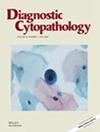Cytomorphological Features of Fine Needle Aspiration in 11 Conventional and 2 Dedifferentiated Chordomas: Correlation With Histopathology
Abstract
Background
Chordoma is a rare malignant tumor of notochordal origin with well-established histologic features and typically distinctive cytomorphology. Fine-needle aspiration (FNA) can offer a valuable diagnostic tool in deep-seated or challenging lesions. However, distinguishing conventional and dedifferentiated chordomas based on cytological features remains difficult and poorly documented.
Methods
Thirteen FNA samples from 10 patients with histologically confirmed chordoma (11 conventional and 2 dedifferentiated), retrieved from the pathology files of a tertiary referral hospital between 1966 and 2022, were retrospectively reviewed. Cytomorphological features were analyzed and correlated with histological subtype and immunohistochemical profile.
Results
All cases showed physaliphorous cells embedded in a myxoid matrix, with varying proportions of single cells and clusters. Prominent nucleoli, binucleation, and nuclear pseudoinclusions were frequently observed. Cytologic atypia and pleomorphism were notable in the dedifferentiated cases but also present, to a lesser extent, in some conventional chordomas. No definitive cytological features of sarcomatous transformation were identified in the smears of dedifferentiated chordoma. Immunohistochemistry supported the diagnosis in selected cases, with positivity for brachyury, cytokeratins, EMA, and negativity for S100 in the physaliphorous cells. Brachyury loss in dedifferentiated areas complicates diagnosis, underscoring the need for conventional component identification.
Conclusion
Chordoma shows distinctive yet variable cytomorphological features that can allow for a reliable diagnosis in FNA samples. Clinical and radiological correlation is essential to guide sampling, especially in the dedifferentiated cases, and avoid misinterpretation. Some cytological features typically associated with dedifferentiation may be present in conventional chordomas, underscoring the importance of cautious interpretation and histological confirmation.

 求助内容:
求助内容: 应助结果提醒方式:
应助结果提醒方式:


